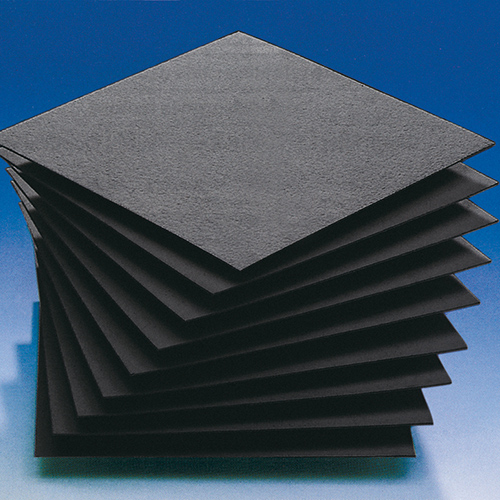For Color and Flavor Correction
Seitz AKS4 series depth filter sheets were developed to satisfy general purpose carbon adsorption applications in the food and beverage industry. Powdered activated carbon (PAC) is widely used in the food and beverage industry for adsorption applications. The use of bulk PAC has significant drawbacks relating to the handling of bulk carbon powder, cleaning of the process equipment, as well as time and costs associated with carbon removal from the process. Seitz AKS immobilized carbon filter media alleviates these concerns by incorporating activated carbon within a matrix of cellulosic fibers. This immobilized carbon media can be coupled with a downstream protective filter paper to prevent any possible carbon particle shedding downstream of the filter. Additionally, the adsorption efficiency of Seitz AKS immobilized carbon filter media is greater than an equivalent amount of bulk powdered activated carbon (PAC), reducing overall process time and increasing product yield. An internal comparative study using the same carbon grade showed up to 150 % better color removal efficiency when compared to bulk PAC.| Features | Benefits |
| Carbon-impregnated media with a homogeneous and consistent matrix |
|
| High adsorption efficiency as compared to PAC |
|
| General-duty media targeted to food and beverage industry needs | High economic efficiency due to a long service life |
- Dechlorination of water
- Correction of off color, flavor and odors in distilled spirits
- Decolorization of sweetener and sugar syrups
- Color correction in juice and beer application
- Gelatin decolorization and deodorization
Food Contact Compliance
- Food contact compliant filters are available. Please consult the Declarations of Compliance for applicable part numbers at the links below.
- Seitz® AKS4 Series Depth Filter Sheets Declaration of Compliance
Main Constituents
- Cellulose, powdered activated carbon, diatomaceous earth (DE, Kieselguhr)
Adsorption Capability
At an optimized flow rate, the probability of contact between the impurities and carbon particles is greater in carbonimpregnated sheets. This is due to process fluids more efficiently contacting carbon particles immobilized into a sheet matrix. Because of the depth (thickness) of the sheet, it is possible to consider the structure as being made up of a series of layers containing PAC. Having a depth of PAC and passing the fluid at an optimal flow rate through that depth enables maximum utilization of the carbon. Macro- and mesopores can generally be regarded as the highways into the carbon particle, and are crucial for adsorption kinetics. Macropores are used for the transport, and adsorption occurs in the meso- and micropores. Small molecules, such as methylene blue, which has a molecular weight of 319.86 Dalton, are mainly captured in micropores. Typically, over 20 g/m2 methylene blue is adsorbed.Characterization
| Sheet with Protection Paper | Mass per Unit Area g/m2 | Thickness mm | Ash % | Water Permeability1 l/m2/min (gal/ft2/min) |
| No | 1050 | 3.8 | 13 | 291 (7.2) |
| Yes | 1050 | 3.8 | 13 | 100 (2.5) |
These figures have been determined in accordance with in-house test methods and the methods of the Technical / Analytical Work Group within the European Depth Filtration Association.
Regeneration
Depending upon the application and the nature of the adsorbed contaminants, AKS series filter sheets may be regenerated by means of rinsing with clean water in the forward direction. However, the achievable regeneration efficiency must be determined by monitoring filtrate quality.Sterilization and Sanitization
| Method | Temperature °C (°F) | Maximum Differential Pressure Bar (psi) | Time2 Cycle min |
| Steam | 125 (257) | 0.5 (7.2) | 20 |
| Hot Water | 90 (194) | 1 (14.5) | 30 |
1The permeability was measured under test conditions with clean water at 20 °C (68 °F) and a Δp of 1 bar (14.5 psi).
2The actual time required may vary as a function of the process conditions.
Quality
- Filter sheets produced in a controlled environment
- Manufactured according to ISO 9001:2008 certified Quality Management System
Wine, Spirits, Spirits
Filter Sheets
General Instructions for Use
To achieve optimal filtrate quality, Pall recommends the use of protection paper downstream. Sheet options which include a downstream protection paper are available3. In order to maximize the required adsorption of impurities, particle filtration must occur upstream of carbon-impregnated filter sheets.Filtration Guidelines
Typical flux rates used on food and beverage fluids are 150- 250 L/m2/h (3.7-6.2 gal/ft2/h).
Higher fluxes may be possible according to the application. Due to the various factors, which may affect the adsorption process, Pall recommends an initial scaled-down testing as a reliable method of qualifying filter performance. For additional operating guidelines, including rinsing of sheets prior to use, please refer to instructions provided by Pall.3Sheets are available with or without downstream protection paper. Please indicate which type is required upon order placement.
Available Sheet Formats
Rectangular Sheets- 400 mm x 400 mm (15.8" x 15.8")
- 600 mm x 612 mm (23.6" x 24.1")
Earn 10% off* your next order online by leaving a review of this product. Please login to your account to leave a review. We appreciate and value your feedback.
*Subject to Terms and Conditions.



